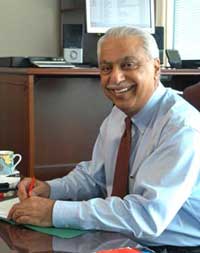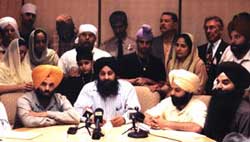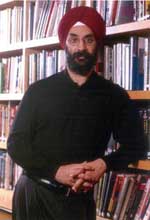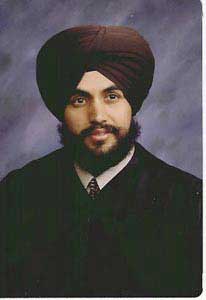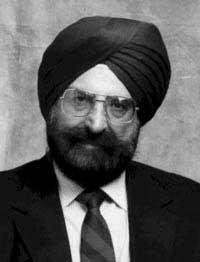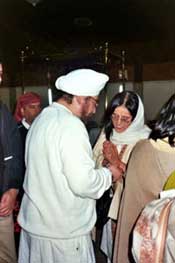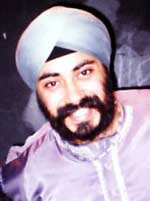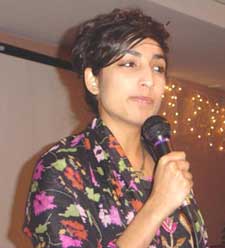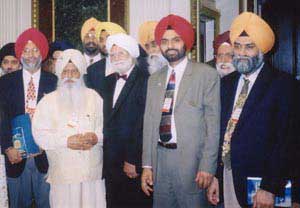Magazine
The Sikhs: In the Shadows of 9/11

|
1984 and 9/11 are defining moments in the lives of Sikh Americans.
“If I see someone (who) comes in that¹s got a diaper on his head and a fan belt wrapped around the diaper on his head, that guy needs to be pulled over,” Congressman John Cooksey, Republican from Louisiana, who serves on the International Relations Subcommittee for the Middle East and South Asia, remarked shortly after the attacks on the Twin Towers on Sept 11, 2001. Under intense public pressure, Cooksey apologized, albeit grudgingly, for his bigoted remarks. 9/11 marked the start of an open season for racists of all against Sikhs, Muslims and other colored people in America. The backlash hit the Muslim community especially hard, because all the 9/11 terrorists were Muslim. Many South Asians discovered themselves caught up in the frenzy after being mistaken for Arab or Muslims, because of the similarity in their looks. The Sikhs were singled out for their turbans, which are often confused with the turbans of Osama bin Laden and his Taliban followers. Indeed, the first known revenge killing, just four days after the 9/11, was of a Sikh, Balbir Singh Sodhi, who was shot five times at point blank range outside his gas station in a seemingly safe suburb of Arizona by a man who pulled up in a pick-up truck. The 9/11 backlash continues to whiplash the Sikh American community to this day.
In September 2004, its ripples touched Gurcharanjeet Singh Anand, a delivery truck driver, whose home was torched in the Bay Area. In July 2004, four Long Island, NY, men were charged with punching and kicking a Sikh priest Rajinder Singh Khalsa into unconsciousness after ridiculing him for wearing a “dirty curtain.” The hysteria against Sikhs has been fuelled in part even by popular culture. The 2003 movie DisFunktional Family features the comedian Eddie Griffin mocking a Sikh man, “Bin Laden, I knew you was around here!” The Sikh Coalition, which monitors bias crimes against Sikhs, alone has logged over 300 hate crimes and bias incidents since Sept 2001, including the vandalism of several Sikh Gurudwaras. Surinder Singh, a businessman based in Atlanta and grandson of the famous Ghadar party leader Bhai Bhagwan Singh Giani, recalls a visit to India on an Air France flight, whose crew would not let him switch seats simply because his last name was Singh. Singh does not even wear a turban. “I had cut my hair after the Iran hostage situation when Sikhs were mistaken for Iranians and I was being heckled everywhere. I had kept my beard. This time the Air France crew was so frightened and paranoid, they wouldn’t let me even get up from my seat.”
Maninder Singh, an engineer and musician based in Chicago, recalls attending a Sept. 11 memorial service outside City Hall in Chicago, wearing a red, white and blue turban. He was approached by a woman who comforted him, saying she forgave him and his Islamic community. Another time at a movie theater an African American man mocked him to his buddies, “There is a suicide bomber sitting in the third row.” Singh says he is appalled that a member of a community that has been victim of racism its entire life would make such a wisecrack. Balbir Sodhi’s brother Rana says until Sept 11 his brothers and he never felt unsafe or discriminated against. “I could go anywhere in the country without fear. I drove a cab for a little while as did Balbir and my brother Sukhpal. It is considered a high risk job, but we never had any cause for concern.”
Rana recalls that on the morning of Sept 11, he was still at home when both his brothers Balbir and Harjeet called and adviced him not to go to work. “I told them, nothing is going to happen here. They were worried, because I worked in the downtown area, which was considered unsafe as compared to Balbir’s gas station in the suburbs.” Rana went to work nonetheless and realized that things had indeed changed very rapidly. “People were showing me the finger. A loyal customer called in asking me to be careful as things were heating up. Balbir and I went shopping to get things for our stores and we could see people acting differently, even the ones who had been our frequent customers, because we had our turbans on.” Balbir and his brothers were preparing to set up a meeting to educate the media and government officials about Sikhs when Balbir was shot. The killer Frank Roque, an engineer, pleaded he had acted in a zeal of patriotic insanity. He has been sentenced to death. “It was proved by one of his colleagues that it was a premeditated attack, because he had told co workers openly he was going to kill those rag head people and their children,” says Rana. Ten months after Balbir Sodhi was shot, his brother Sukhpal was gunned down in San Francisco in what many in the community believe was a racially motivated attack, although the police have classified it as a random shooting.
“All his belongings, along with $300 in cash in his pockets were found intact. How can we believe it was a random act of violence?” asks Rana. For the Sodhis the outpouring of love after two family funerals has been therapeutic. Four thousand people turned up at Balbir’s funeral. “It is that love that has given us strength,” says Rana. It was more than a week before the Bush administration stepped up to acknowledge that the Sikhs were also Americans and Valarie says she began to recall her school history projects designed to acquaint her classmates about partition, about 1984, events that had gone undocumented in history books. She began wondering if these atrocities on her community would also face the same historical fate. “Growing up in my small home town of Clovis in California, where every one knew each other, I was never conscious of my color and yet as I ploughed through the country I realized I’m much more a part of my community than I had realized earlier.”
With her cousin brother Amandeep, Valarie traveled all over the United States for four months, videotaping and recording the experiences of Sikh Americans, many of whom recounted horrific tales of the backlash. She learnt about a Sikh man who reached out to help near the twin towers area and had to run for his life as people turned on him accusing him of terrorism. She met a Sikh woman who was stabbed because of her color and told, “This is what you get for what your people have done to us.” It hit close to home when people began yelling at her turbaned brother and her at a gas station in Washington DC to go back to her country. Presently Valarie is studying the effects of violence on religion at Harvard University, where she is also producing a documentary film based on her video documentation. Says Valarie of the traumatic aftermath of Sept 11: “I became a part of the dark history of terror, violence and hatred that was being created, and it has become a mission to speak up. The Sikhs must stand up and fight for themselves, because now the difference between speaking up and staying silent becomes the difference between life and death.” Indira Assassination Even before 9/11, Sikhs experienced hostility in the United States during the Iranian hostage crisis of 1979, when they were mistaken for Iranians. The Sikh separatist movement by a segment of Sikh hardliners, the government assault against rebels at the Golden Temple in Amritsar and the assassination of Indira Gandhi in 1984 cast a dark shadow of suspicion over the entire Sikh population both in India and the United States.
Rana Sodhi recalls how his family in Punjab was caught up in the turmoil. “If you didn’t agree with those Sikhs who wanted to create a separate state, they came after you and, on the other hand, our businesses were closed because the government would target the Sikhs and impose indefinite curfews. So how does one survive?” Surinder Lalli, currently a business entrepreneur based in Georgia , who was pursuing his PhD in India in 1984 was arrested after leading a peaceful rally and his brother disappeared and has never been found. He says his Hindu friends were afraid to interact with him and he decided to move to the United States. He recalls that Sikhs became very introverted, subdued and unwilling to mingle in the mainstream, because they were being portrayed as terrorists. Raman Singh, an engineer and business entrepreneur in Michigan, says 1984 was a very defining period for her. “I was 18 and the attack on the Golden Temple was really the defining moment for me and for many Sikhs. I couldn’t understand all this talk about Sikhs in India and Sikhs outside of India. I will always be an Indian Sikh by virtue of my ethnicity and heritage and what am I supposed to try and choose? To be a Sikh and not Indian, or to be an Indian, but not a Sikh? It was a very emotionally trying year for me. I wasn’t old or mature enough to realize these were all political games, but it did galvanize my Sikh instincts. The intense hatred I felt that year made me even more determined to raise my kids as American Sikhs. They have an Indian heritage but for me it’s more important that they be in touch with their Sikh roots.”
Dr Pashaura Singh, a faculty member at the University of Michigan, says after he participated in a protest march condemning the atrocities against Sikhs following Indira Gandhi’s assassination, he was blacklisted and denied a visa to travel to India in 1989. “Before the assassination it was a matter of pride for us to be Sikhs, but after 1984, we found ourselves always being defensive, always giving explanations to anyone who would be willing to hear us out or get to know our community better.” Assimilation Because of their distinctive looks and turbans, assimilation has never been easy for Sikhs in America. The specter of terrorism, with which all Sikhs were broadly tarred, oftentimes through Indian government propaganda, made life especially hard even for Sikhs living overseas. Nevertheless, alienated as many Sikhs were from India in the 1980s, they became ever more determined to find their new identity in their adopted homeland. Today an estimated 200,000 to 300,000 Indian Sikhs live in America and another 150,000 in Canada. In addition, there are several thousand American adherents of the faith, mostly followers of Yogi Bhajan and his 3HO Foundation. Sikhs are the second largest group within the Indian community, after only the Gujaratis, constituting 10 percent of the Indian American population, which is almost five times their proportion in India.
Sikhs pioneered Indian immigration to the United States in the early 1900s, where they labored in lumber mills, railroads and forestry, concentrating specially in Yuba City and the Imperial Valley in California. Until fairly recently, Yuba City had the largest proportion of Indians in any city in the United States. Because the laborers were barred in the 1900s from bringing family, many of them ended up marrying Mexican women and today these Sikh Mexicans continue to have a very visible presence in the Imperial Valley. Indeed, the mayor of El Centro, David Singh Dhillon, is a third generation Punjabi Mexican American. Sikhs were also deeply involved in India’s Independence struggle through the Ghadar Party and in 1956, soon after Sikhs won right to U.S. citizenship, a Sikh, Dilip Singh Saund, became the first and only South Asian to ever serve as a South Asian Congressman, a record broken only last year when Bobby Jindal entered Congress from Lousiana. Early Sikh migrants were blue collar laborers and until recently the Sikh community was predominant in the farming and transportation industry, especially in the taxicab, gas station and auto repair sectors. However, today Sikhs, like other Indians, are very diverse in their range of business and professional ventures. They serve as leading academics, professionals and entrepreneurs. Dr Narinder Kapany is recognized as the father of fiber optics and is renowned for his inventions in the areas of fiber-optics communications, lasers, biomedical instrumentation, solar energy and pollution monitoring. Kanwal Rekhi and Kavelle Bajaj were pioneers among Indian entrepreneurs in information technology. Alexei Grewal won the gold medal for the United States in the Men’s Road Race in the 1984 Olympics and Satwant K. Dhamoon, is considered among New York’s leading gynecologists. Last year, 21-year-old U.S. Army Specialist Uday Singh became the first Indian and Sikh casualty in Operation Iraqi Freedom when his convoy was ambushed in Habbaniyah near Baghdad.
Jeet Bindra, presently president of global hrefining at Chevron, arrived in Seattle in 1969 with $8. “It was a very strange feeling to be dumped in a land where no one looks like you. You wonder if they have the remotest idea where you are from, and will they treat you nicely?” Bindra, who worked as a cook and a research assistant to support his education, recalls: “I got questions like what is under the turban, why does your beard stick to your face since I tied it with a thread. It got more difficult to keep my hair when I started to work at Chevron in 1977.” When he broke into management at Chevron, Bindra had to cut his hair to conform to the company’s safety requirements, which was heartbreaking for him. “My son didn’t recognize me when I walked through the door. When I called his name, he looked taken aback and asked tentatively, ‘Is that you daddy?’ I couldn’t look at myself in the mirror for weeks.” Jagtar Singh, who came to the United States from Punjab in 1985 at age 10, similarly found the transition rough. “One time someone tried to pull off my turban, another time a girl even cut off some of my hair, and I didn’t know English, so I would get into fights all the time.”
Chicago’s Maninder Singh says, “When I went to nursery school, no one wore a patka (cloth head gear for Sikh youths) or was even Indian.” Later in elementary school Maninder says he was bullied, his patka squeezed and he was taunted with names like turbie. “I would get off at the bus stop weeping.” Maninder was raised in a gurudwara in Calgary, which he says made it easier to embrace everything at face value, because everybody else did the same thing, but that changed when his family moved to Toronto and later to Michigan. Maninder says as he grew older, he found it harder as he discovered himself pulled in many different directions. “There were the fundamentalists, the scholars, the secular, the Sikhs without the hair and turban, and then the non Sikhs. Through it all I had to strive to be the Sikh, who didn’t drink, smoke or cut his hair – the oddity within the minority. I forced myself to mingle, to become more outgoing, to break cultural barriers out of a need for self preservation.” Dr Inderjit Singh, who came to United States and presently teaches at New York University, says he found greater acceptance in Oregon than in New York. “Sometimes when I was lonely I would go and sit in a diner near a church on a Sunday and after church as people trooped in for lunch, someone’s missionary zeal would be aroused and I would be approached, so that my soul could be saved.” In the process not only did he learn more about Christianity and Judaism, he also learnt a lot about Sikhism, because he was invited to make presentations at churches. What Lies Ahead
Many Sikhs, who were alienated from India in the 1980s, see a fresh opportunity for reconciliation under the new administration of Manmohan Singh, India’s first Sikh prime minister. The wounds inflicted after the Indira Gandhi assassination have started to heal and the turban has taken on a new, positive identity, with the prime minister’s face and headdress gracing leading publications and beaming on television worldwide. Mohanbir Sawhney, who teaches at the Kellogg School of Management, says when he came to the United States in 1991, India was not a factor in Sikh identity. “We may have crowed about our 5,000 years of culture but no one gave a rat. Today, it is cool to be an Indian and a Sikh.” Sawhney adds that although the economic clout of the community is far greater than its political clout, that too is starting to change as the community becomes more engaged with the mainstream political process. “The younger generation is working in campaigns and running for political offices. We have tried to support our local politicians and nobody in Illinois gets elected today without acknowledging the Sikhs and the Indian community.” Ujjal Singh Dosanjh the first Indian and Sikh Prime Minister of British Columbia is currently Canada’s health minister. Dosanjh says that the Canadian political system is much more akin structurally to the Indian political system and easier for the Sikhs to navigate than the U.S. system. “I also get the sense that the U.S. political system is much less open to the inclusion of diversity. Money and contacts seem to play a greater role than real activism. In Canada many of us rose from the ranks fighting for equality against racism, rights for the farmers and succeeded. I don’t see that in the USA.”
Says Atlanta businessman Surinder Singh: “We have come a long way globally. In 1913 we could not even travel in buses or rent a hotel room in Canada or sit in a movie theater. My grandfather Giani Bhagwan Singh would often spent nights sitting on a railway bench at the train station. Sometimes they would let dogs loose on him. My grandfather fought against that bigotry in court and won, opening doors so the future generations could thrive.” SALDEF (Sikh American Legal Defense and Education Fund ) had already been created before 9/11and the Sikh Coalition was formed after 9/11 to monitor and expose hate and bias incidents against the community. Chevron’s Bindra recalls a SALT (South Asian Leaders of Tomorrow) survey on hate crimes, which identified nearly 600 hate crimes against Sikhs, Muslims and Middle Easterners in the first 30 days after 9/11. “We immediately prepared and distributed hate crime videos to all non profit organizations, stressed on education and saw a significant and positive shift in understanding.” Law enforcement agencies and district attorney offices hired Sikhs and they were also brought into advisory committees. After the 9/11 backlash against Sikhs the Bush White House stepped up its public support for Sikhs, which Rajwant Singh cites as a creditable development for the community. Another major milestone was reached on Aug 18, 2004 at the White House, which celebrated the 400th anniversary of Sri Guru Granth Sahib, the holy book of the Sikhs. Rajwant Singh credits the Clinton administration for inviting Sikhs formally to the White House, which helped to dispel the negative propaganda against the community. “That has created a lot of recognition and credibility for the community and began the initial recognition and dialogue process. Mainstream America took note as well.” Uttam Dhillon, chief counsel and deputy staff director of the House Select Committee on Homeland Security, says the administration is acutely aware of the Sikh community’s concern about racial profiling and is responsive to those needs. The U.S. Justice Department’s Civil Rights Division in collaboration with SALDEF recently issued a poster to explain key elements of Sikhism and its followers to Americans, depicting traditional Sikh headgear and advocating respect and toward Sikhs during security checks. Dhillon, who is of mixed Sikh and Mexican heritage, says he is excited to see the Sikh community become such an important part of the mainstream in recent years. “There are a lot of Sikhs and Indians on the Hill, something you didn’t see a few years ago.” Sikhs, he says, understand the need to form strong coalitions with other ethnic communities, do more outreach programs and get the younger generation involved in mainstream issues. For a lengthier version of this article, visit the author’s website at kavitachhibber.com |

